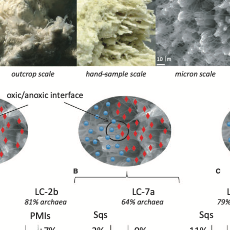Link to online paper: https://onlinelibrary.wiley.com/doi/10.1111/gbi.12062
Abstract
Samples of young, outer surfaces of brucite–carbonate deposits from the ultramafic-hosted Lost City hydrothermal field were analyzed for DNA and lipid biomarker distributions and for carbon and hydrogen stable isotope compositions of the lipids. Methane-cycling archaeal communities, notably the Lost City Methanosarcinales (LCMS) phylotype, are specifically addressed. Lost City is unlike all other hydrothermal systems known to date and is characterized by metal- and CO2-poor, high pH fluids with high H2 and CH4 contents resulting from serpentinization processes at depth. The archaeal fraction of the microbial community varies widely within the Lost City chimneys, from 1–81% and covaries with concentrations of hydrogen within the fluids. Archaeal lipids include isoprenoid glycerol di- and tetraethers and C25 and C30 isoprenoid hydrocarbons (pentamethylicosane derivatives – PMIs – and squalenoids). In particular, unsaturated PMIs and squalenoids, attributed to the LCMS archaea, were identified for the first time in the carbonate deposits at Lost City and probably record processes exclusively occurring at the surface of the chimneys. The carbon isotope compositions of PMIs and squalenoids are remarkably heterogeneous across samples and show highly 13C-enriched signatures reaching d13C values of up to +24.6&. Unlike other environments in which similar structural and isotopic lipid heterogeneity has been observed and attributed to diversity in the archaeal assemblage, the lipids here appear to be synthesized solely by the LCMS. Some of the variations in lipid isotope signatures may, in part, be due to unusual isotopic fractionation during biosynthesis under extreme conditions. However, we argue that the diversity in archaeal abundances, lipid structure and carbon isotope composition rather reflects the ability of the LCMS archaeal biofilms to adapt to chemical gradients in the hydrothermal chimneys and possibly to perform either methanotrophy or methanogenesis using dissolved inorganic carbon, methane or formate as a function of the prevailing environmental conditions.
